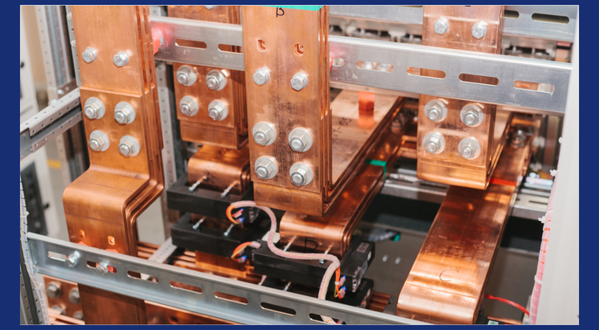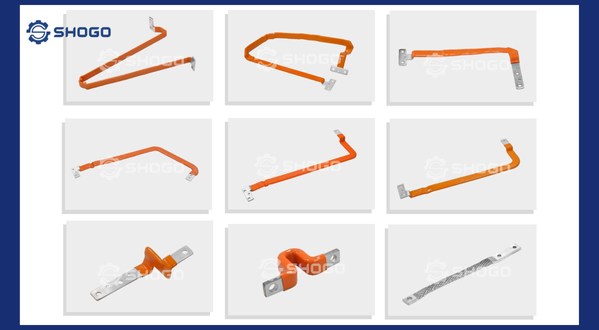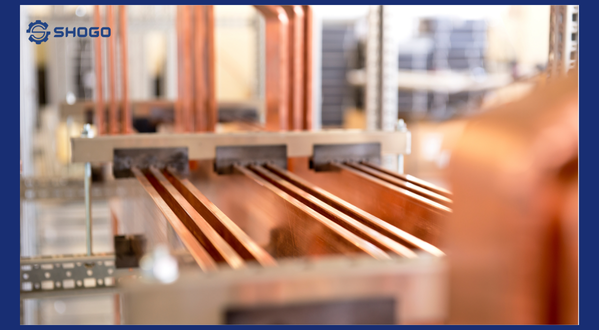
Electrical cabinet busbar, also known as electrical cabinet busbar, plays an extremely important role in the electrical system, such as the “heart” that operates all activities. As the main electrical conduction and power distribution part, the busbar ensures smooth, safe and efficient operation of the system. This article will provide you with detailed information about electrical cabinet busbars, helping you better understand the function, structure, classification, applications, selection and some important notes.
1. What is an electrical cabinet busbar?
Electrical cabinet busbar is an electrical conductive bar installed inside the electrical cabinet, whose main task is to conduct electricity from the power source (generator, power grid) to electrical equipment in the system such as transformers, circuit breakers, circuit breakers,…

Key functions of electrical cabinet busbar:
- Conducting electricity: Busbar acts as the main path, transmitting electricity from the power source (generator, power grid) to electrical equipment in the system such as transformers, circuit breakers, circuit breakers, etc. ..
- Power distribution: Busbar divides the power flow from the power source into many small branches, providing each specific electrical device with the appropriate level.
- Device connection: Busbar helps connect electrical devices in electrical cabinets together, forming a complete electrical system.
2. Detailed structure of electrical cabinet busbar:
Electrical cabinet busbar is composed of the following main parts:
- Conductive core: Is the most important part, usually made from a good conductive material such as copper or aluminum. The conductive core can be solid bar or hollow bar, depending on design and usage requirements.
- Insulation layer: Wraps around the conductive core, has the role of isolating the conductive core from the cabinet cover and other parts, ensuring user safety and preventing electrical leakage. Common insulating materials include Epoxy, PVC or Mica.
- Included accessories: Includes parts such as support bars, tie bars, cable connectors, fixing clamps,… to help fix the busbar firmly inside the electrical cabinet and connect with other electrical equipment.
3. Diverse classification of electrical cabinet busbars:
Electrical cabinet busbars are classified according to many different criteria to meet diverse usage needs:
- By material: Copper busbar (good electrical conductivity, high load capacity) and aluminum busbar (lighter, cheaper price).
- By structure: Solid bar busbar (simple structure, low cost) and hollow bar busbar (better heat dissipation, suitable for large current).
- According to voltage: Low voltage busbar (used for low voltage power systems), medium voltage busbar (used for medium voltage power systems) and high voltage busbar (used for high voltage power systems).
- According to the level of coverage: Uncovered busbar (for dry environments) and covered busbar (for wet, dusty environments).

4. Wide applications of electrical cabinet busbar:
Thanks to outstanding advantages such as good electrical conductivity, flexible connection, simple structure, safety and high durability, electrical cabinet busbars are widely used in many fields:
- Industrial electrical systems: Factories, factories, industrial parks,…
- Building electrical systems: Office buildings, high-rise apartments,…
- Postal and telecommunication electrical systems: Transformer stations, broadcasting stations,…
- Transportation electrical system: Bus station, airport, train station,…
- In addition, busbars are also used in other electrical systems such as: Solar power systems, wind power systems, UPS systems,…
5. Instructions for choosing a suitable electrical cabinet busbar:
To choose an electrical cabinet busbar that suits your needs, you need to keep in mind some important factors:
- System voltage: Select a busbar whose voltage matches the system voltage.
- Current: Choose a busbar that can handle the current load appropriate to your needs.
- Size of electrical cabinet: Choose a busbar with a size appropriate to the size of the electrical cabinet.
- Installation environment: Choose a busbar that can withstand the environment appropriate to the installation conditions.
6. Some important notes when using electrical cabinet busbar:
- Installation of electrical cabinet busbars needs to be performed by a qualified technician, ensuring safety and accuracy.
- Clean the electrical cabinet busbar periodically to remove dust and ensure good electrical conductivity.
- Check the electrical cabinet busbar regularly to detect damage early and take timely remedial measures.
- Use appropriate protective devices such as circuit breakers and overload relays to protect the busbar and electrical system.
7. Conclusion:
Electrical cabinet busbars play an extremely important role in the electrical system, directly affecting the safety, efficiency and longevity of the system. Choosing the right busbar and using it properly will contribute to ensuring the electrical system operates smoothly, is durable and saves energy.












